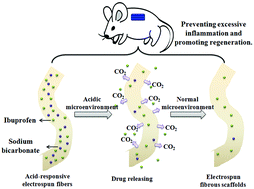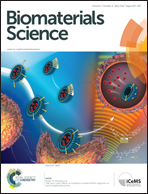Ibuprofen-loaded electrospun fibrous scaffold doped with sodium bicarbonate for responsively inhibiting inflammation and promoting muscle wound healing in vivo
Abstract
Infection or inflammation can cause the in vivo microenvironment to become acidic, and an inappropriately excessive inflammatory response can significantly delay the healing process. A feasible acid-responsive ibuprofen-loaded poly(L-lactide) (PLLA) fibrous scaffold with doped sodium bicarbonate has been designed to prevent an excessive inflammatory response and promote regeneration. The results of the in vitro drug release study show that the acid-responsive fibrous scaffold exhibited a quick drug releasing response at pH 5.0 and a slow drug releasing response at pH 7.4. The in vivo rat muscle wound model study shows that the acid-responsive ibuprofen-loaded PLLA fibrous scaffold caused slighter inflammation and an earlier reparation. The immunohistochemical staining and quantitative real-time polymerase chain reaction analysis further showed that the scaffold caused lower levels of inflammatory factors and a higher expression of repair factors during the whole observation. Taken together, through the muscle wound healing process, the results demonstrate that the acid-responsive ibuprofen-loaded PLLA fibrous scaffold shows a better performance in preventing excessive inflammation than scaffolds that do not contain ibuprofen or are not acid-responsive. Additionally, the acid-responsive ibuprofen-loaded PLLA fibrous scaffold also has a faster healing process than others.


 Please wait while we load your content...
Please wait while we load your content...